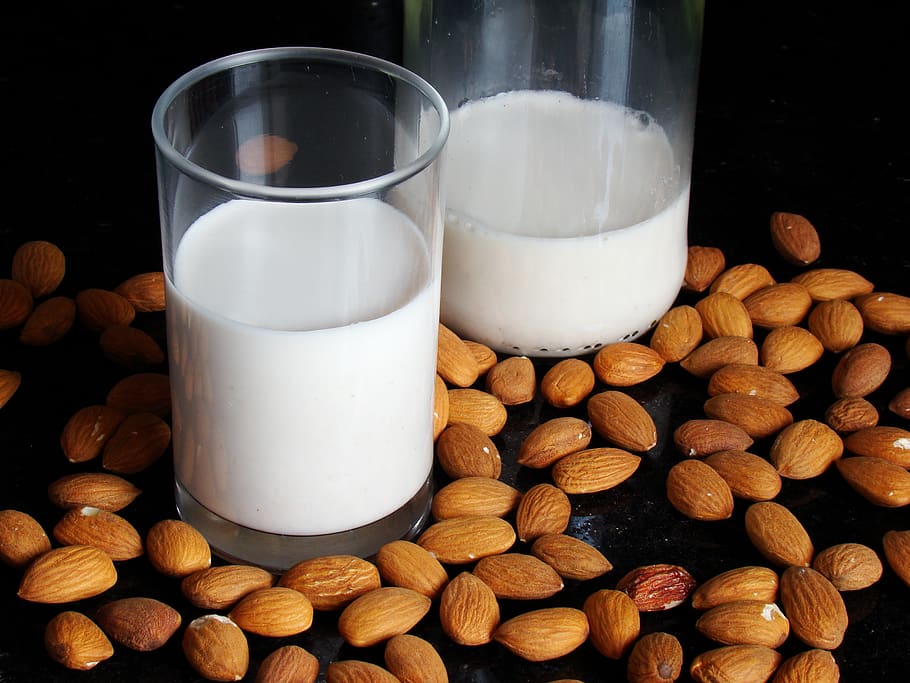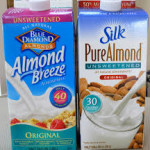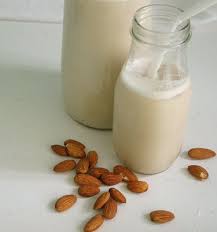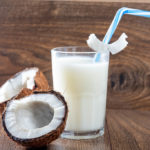Homemade Almond Milk and Coconut Milk
Recipe Key
Making almond milk and coconut milk at home is much healthier than the containers you buy in the store and it’s not too hard. I’ll show you how.
What You May Not Know About Your Non-Dairy Milk
 It is estimated that nearly 50 million Americans have some degree of “lactose intolerance” As a result many people turn to the many “non dairy” milks available at the supermarket and health food stores. You can find “milks” made from soy, almonds, coconut and hemp to name a few.
It is estimated that nearly 50 million Americans have some degree of “lactose intolerance” As a result many people turn to the many “non dairy” milks available at the supermarket and health food stores. You can find “milks” made from soy, almonds, coconut and hemp to name a few.
While these milks may be beneficial for those who are truly lactose intolerant, they are not as nutritional valuable as you have been led to believe.
A Processed “Health” Food
There is a billion dollar industry that has positioned themselves as a “healthy” alternative to cow’s milk, but the truth is they really are a processed food in the so-called “health foods” industry.
During processing, seeds, nuts or grains are heated to high temperatures and sometimes extracted with chemical solvents (like hexane). The resulting product is one that bears little resemblance – nutritionally or visually – to cow’s milk. Consumers want a product that looks, tastes and flows like cow’s milk.
So along comes fortification …
Since most people buy dairy free milk as a substitute for cow’s milk, the companies often enrich their almond milks with Vitamin A and D and other ingredients which make the dairy free milk appear more similar to cow’s milk.
Let me tell you what bothers me the most…
Carrageenan… Do you really want to eat it?
Carrageenan is an additive derived from seaweed and is used as a stabilizer and thickener to give it a better consistency on your tongue. The FDA considers it safe but many scientists don’t agree.
Joanne K. Tobacman, M.D., associate professor of clinical medicine at the University of Illinois College of Medicine,has published 18 peer-reviewed studies that address the biological effects of carrageenan and is convinced that it is harmful to human health. In April 2012, she addressed the National Organic Standards Board on this issue and urged reconsideration of the use of carrageenan in organic foods.
Dr. Tobacman said that her research has shown that exposure to carrageenan causes inflammation.
The FDA denied a petition to re-examine the safety of carrageenan and it is still an approved ingredient in organic products, but a few companies like Stonyfield have pledged to reformulate their products that currently use the additive.
You can eat anything once in a while without harm, but I recommend avoiding regular consumption of foods containing carrageenan. This is especially important advice for persons with inflammatory bowel disease.
Adding in Vitamins D & A
While adding vitamins into the dairy free milk may seem like a good idea to make it more like cows milk, the truth is isolated, synthetic nutrients do not behave the same way in the body that naturally-occurring nutrients do. In fact, the synthetic forms of many nutrients can actually promote – not reduce – the risk of poor health and disease.
Consider 2 of the most common (synthetic) versions of vitamins commonly found in dairy-free milks:
Vitamin D2
Vitamin Dis one of the most important vitamins you need for long term health. Studies show it reduces the risk of chronic disease including cancer, heart disease, diabetes and more. Vitamin D3 is the form that occurs naturally. The type typically added to most non-dairy milks is vitamin D2 which is a synthetic version made by irradiating fungus.
A recent study of 94,000 people by the Cochrane Database on mortality rates showed those supplementing with vitamin D3 reduced their mortality rate by 6% and the people who supplemented with vitamin D2 increased their mortality rate by 2%. This won’t kill you but it is something to be aware of.
Vitamin A Palmitate
Natural vitamin A (retinol) is a powerful antioxidant, with a wide range of health benefits. It originates from animal foods, including cod liver oil, liver, organ meats, butter, eggs and milk as well as vegetables like carrots, sweet potatoes, squash and greens. We need Vitamin A and it is good for you. When you get it naturally from your food you will never get too much.
The problem is that in excess, the isolated chemical form (vitamin A palmitate) is associated with tumors, enlargement of the liver and spleen, joint disorders, osteoporosis, extreme dryness of eyes, mouth and skin, birth defects, and immune suppression.
Sweetened non-dairy milk has almost as much sugar as a cola.
If you buy processed non-dairy milk it is best to always get unsweetened as the sweetened ones are full of agave nectar, brown rice syrup or just sugar which brings the sugar content in an 8 oz serving to almost the same level as a cola
You can enjoy delicious whole food dairy free milks…
 The good news is you can enjoy diary-free nut milks that are made purely from whole foods. almond or coconut milk. Homemade nut milks have high nutrient levels, a low glycemic index and a rich creamy taste.
The good news is you can enjoy diary-free nut milks that are made purely from whole foods. almond or coconut milk. Homemade nut milks have high nutrient levels, a low glycemic index and a rich creamy taste.
To make homemade nut milks you will need a regular household blender or Vitamix and a nut bag or cheesecloth. You can see my video to see how to make it with the cheese cloth, it’s quite messy but it works. It is easier and less messy using a nut milk bag which can be found in many health food stores or online here.

Sometimes it’s just not possible to make almond or coconut milk at home. If you buy almond milk from the store look for brands that have to carrageenan. I like this brand of almond milk, available in many health food stores.
When using coconut milk in soups and sauces I actually like this brand better than the homemade, it’s has a richer taste. If I use coconut milk in a smoothie or chia pudding I prefer homemade because its lighter. For store bought I like this brand.
For your own fresh almond or coconut milk follow the easy, wholesome and delicious recipes below:
Almond Milk
- Prep Time: 5 mins
- Total Time: 5 minutes
- Yield: 3 cups 1x
- Category: Nut Milk
- Cuisine: Healthy
Ingredients
- 1 cup raw almonds*
- 3 cups filtered water
Instructions
- Place almonds in a bowl and cover with filtered water. Place in refrigerator and soak overnight (for 8-12 hours).
- Rinse and drain the almonds. Place into a blender along with 3 cups filtered water.
- Blend on high in a high speed blender (Vitamix) for 3 minutes or regular blender for 5 minutes..
- Place a nut milk bag or cheese cloth and strainer over a large bowl. Slowly pour the almond milk mixture into the bag.
- Gently squeeze the bag to release the milk.
- Store in a glass jar in the refrigerator for 3-5 days.
Notes
Almond have to soak overnight before blending.
Homemade Coconut Milk
- Prep Time: 15 mins
- Total Time: 15 mins
- Yield: 2 cups 1x
Ingredients
- 1 cups unsweetened organic shredded coconut
- 2 cups filtered water
Instructions
- Heat water in a saucepan to near boiling.
- Add hot water and shredded coconut to blender.
- Blend on high for 3 minutes until creamy.
- Pour mixture through a nut bag or a colander lined with a cheesecloth.
- Squeeze the cheesecloth well to extract coconut milk.
- Store in a glass jar in the refrigerator for 3-5 days.



How would one make rice milk? That is the staple in this house, they like that it is a similar consistency to milk. Ingredients are: filtered water, brown rice, expeller pressed high oleic safflower oil and/or canola oil, tricalcium phosphate, natural vanilla flavor with other flavors: sea salt, vitamin A palmitate, vitamin D2, Vitiamin B12.
So I see the canola oil, vit d2 would be a problem. What is tricalcium phosphate?
Do you see anything else wrong with these ingredients?
Hi Debbie,
The rice milk you are using at least does not have the carrageenan but the canola oil, vitamin A and D2 and knows what they mean by other flavors. There are no regulations for what ingredients fall into that category.
Tricalcium phosphate is a calcium salt of phosphoric acid. It is also known as bone ash. It acts as a firming or anti-caking agent, or as an acidity regulator or to add smoothness and an opaque color. When added to food, tricalcium phosphate increases the level of calcium. There are no known side effects of consuming tricalcium phosphate in foods, but contact with the substance directly has led to reports of nausea, a loss of appetite, vomiting, constipation, dry mouth and increased thirst and urination. Also it may not be vegan because it may come from the bones of animals.
Making your own is always the cleanest most loving food if time permits
Here is an easy recipe for making rice milk at home. Some people make it with cooked rice which is fine but I like the toasted raw rice flavor better. Let me know what your family thinks of it.
1/2 cup brown rice
2 cups water
Pinch of sea salt
Honey, maple syrup (optional)
1/4 teaspoon vanilla extract (optional)
In a dry skillet over medium heat, toast rice grains, stirring frequently until fragrant and just starting to color, about 4 minutes. Transfer to a bowl or jar and add 2 cups water. Set aside to soak overnight or for at least 8 hours
When soaking is complete, pour rice and water into blender, add salt, sweetener and vanilla (if using, and blend at highest setting until rice grains are no longer visible, about 2 minutes in a vitamix and 4 minutes in a household blender.
Strain the rice using a nut milk bag or cheese cloth, squeezing to extract all the liquid. Store in a clean glass jar.
Chill rice milk thoroughly before serving (it tastes better cold). Shake well before each use.
The rice milk will keep about 3 days in the refrigerator
I have had a few emails asking about lactose free milk so here is some information about it.
People buy lactose-free milk because of symptoms of lactose intolerance such as gas, bloating and diarrhea Lactase, an enzyme produced by the stomach, breaks down the milk sugar galactose so you can absorb those milk sugars. Lactose intolerance occurs when you don’t make enough of the enzyme lactase, which breaks down the sugar in milk. When the sugar stays undigested, you may have symptoms mentioned above. Milk companies treat these milks with lactase so that the milk sugar is completely broken down. Nutritionally, lactose-free cow’s milk is comparable to regular cow’s milk. The lactose free milk still has casein, a protein in cows milk which may still cause inflammation. I usually limit my dairy as we are not really designed to have too much cows milk, it does cause inflammation.
Oh snap, thank you very much for posting this! It is gonna aid me when I get Coconut Milk online! Very Fantastic!
I am glad you liked the post. You can also make your own coconut milk at home. Here is a link to the recipe
https://eatwellenjoylife.com/coconut-milk-a-miracle-food-your-can-make-at-home/
GREAT ! You convey the impression as if you have an implausible knowledge on it and its your gratefulness for giving out and imparting your knowledge and blog with others.
Slim Shaper
asthijivak